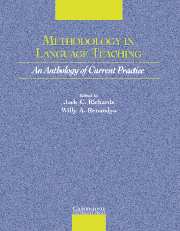Book contents
- Frontmatter
- Contents
- Acknowledgments
- Introduction
- Section I Approaches to Teaching
- Section 2 Lesson Planning and Classroom Management
- Section 3 Classroom Dynamics
- Section 4 Syllabus Design and Instructional Materials
- Section 5 Task and Project Work
- Section 6 Learning Strategies
- Section 7 Teaching Grammar
- Section 8 Teaching Pronunciation
- Section 9 Teaching Speaking
- Section 10 Teaching Listening
- Section 11 Teaching Vocabulary
- Section 12 Teaching Reading
- Section 13 Teaching Writing
- Section 14 Assessment
- Section 15 Technologies in the Classroom
- Section 16 Professional Development
- Credits
- Author Index
- Subject Index
Section 2 - Lesson Planning and Classroom Management
Published online by Cambridge University Press: 10 November 2010
- Frontmatter
- Contents
- Acknowledgments
- Introduction
- Section I Approaches to Teaching
- Section 2 Lesson Planning and Classroom Management
- Section 3 Classroom Dynamics
- Section 4 Syllabus Design and Instructional Materials
- Section 5 Task and Project Work
- Section 6 Learning Strategies
- Section 7 Teaching Grammar
- Section 8 Teaching Pronunciation
- Section 9 Teaching Speaking
- Section 10 Teaching Listening
- Section 11 Teaching Vocabulary
- Section 12 Teaching Reading
- Section 13 Teaching Writing
- Section 14 Assessment
- Section 15 Technologies in the Classroom
- Section 16 Professional Development
- Credits
- Author Index
- Subject Index
Summary
INTRODUCTION
The two articles in this section focus on two aspects of a language lesson: planning the lesson and managing learner behavior during a lesson. Planning is often viewed as a key aspect of teaching a successful lesson. During the planning phase, the teacher makes decisions about goals, activities, resources, timing, grouping, and other aspects of the lesson. Harmer (1991) includes the following elements in a lesson plan:
a. Description of the class
b. Recent work
c. Objectives
d. Contents (context, activity and class organization, aids, language, possible problems)
e. Additional possibilities
Even though a lesson may have already been planned (by the textbook writer), a teacher will still need to make decisions that relate to the needs of his or her specific class, adapting the lesson from the book in different ways to make it better suit the class. This process of planning and adaptation is a crucial dimension of teaching because during this process the teacher makes many decisions that are essential for a successful lesson. Planning can be regarded as a process of transformation during which the teacher creates ideas for a lesson based on understanding of learners' needs, problems, and interests, and on the content of the lesson itself. This does not necessarily result in a detailed, written lesson plan. Many teachers teach successful lessons based on mental plans or on brief lesson notes.
- Type
- Chapter
- Information
- Methodology in Language TeachingAn Anthology of Current Practice, pp. 27 - 29Publisher: Cambridge University PressPrint publication year: 2002



